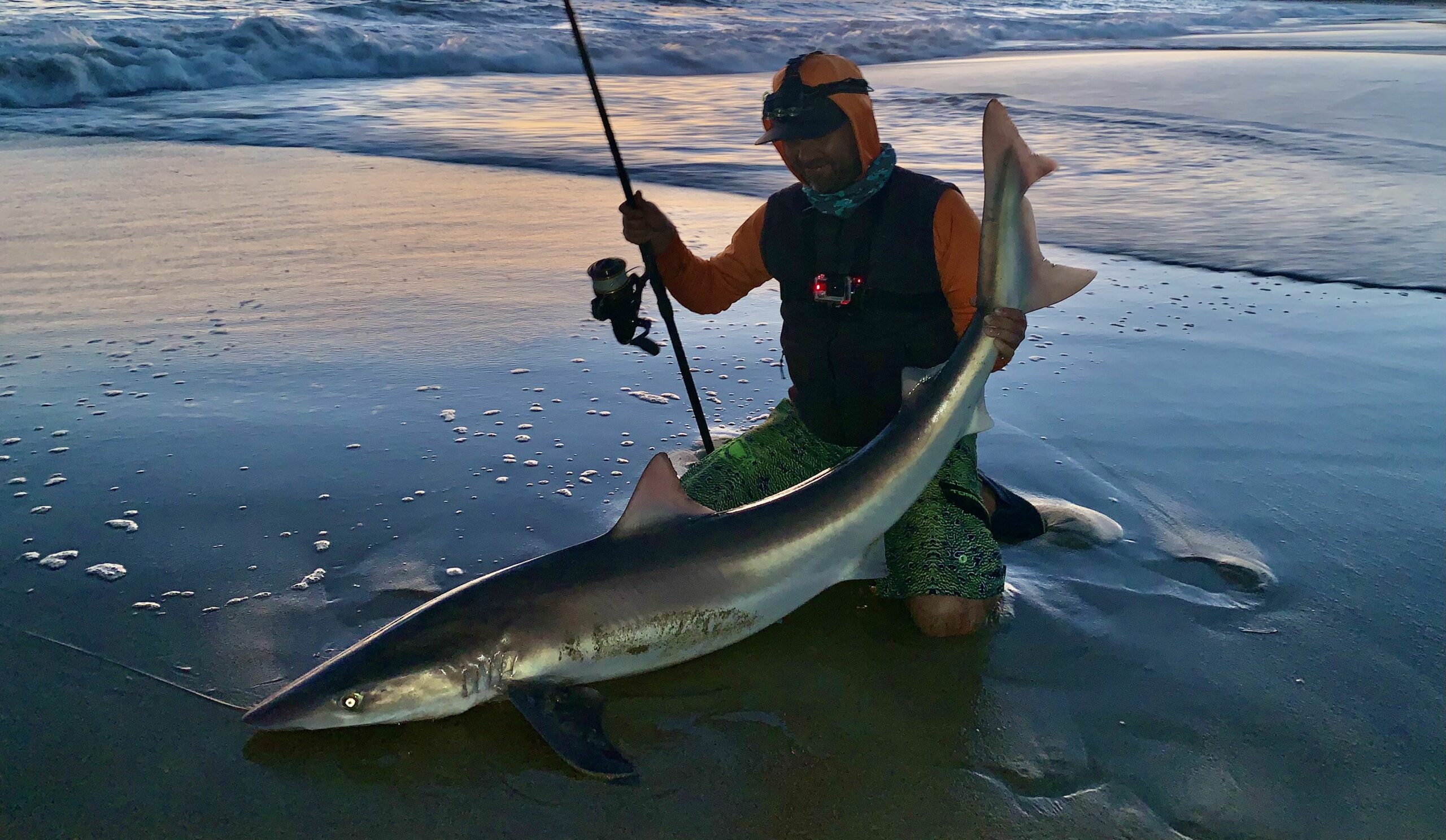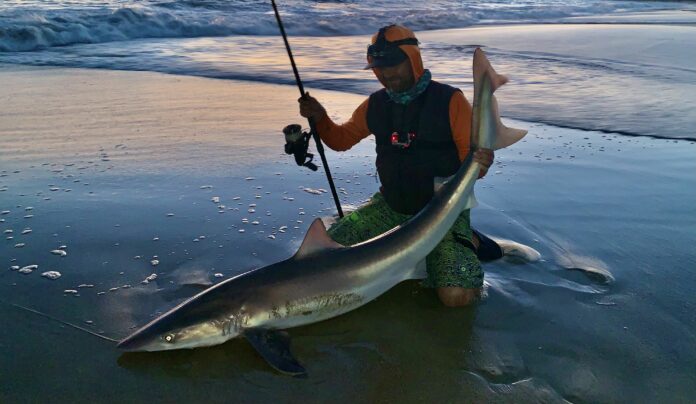BY BEN HERVEY-MURRAY
Last year, Assembly Bill 2109 was signed into law, setting out added protections for great white sharks from efforts to deliberately catch them on rod and line in California. The bill is officially summarized by the California Department of Fish and Wildlife with the following statement:
“The new restrictions aim to get ahead of activities that may lead to increased interactions between white sharks and humans, and to give law enforcement more tools to protect white sharks from intentional efforts to catch or attract them.
The new law also helps protect the public from interactions with white sharks that have been unintentionally hooked by fishermen by restricting when and where chum and shark bait can be used, while still allowing other legal fishing activities to continue.”
So far, so good. Nobody wants to encounter great whites on sport fishing tackle and all the legal jeopardy and potential danger such an accidental capture entails. However, the way the bill is worded will have far-reaching implications for everyday surf, pier and sportboat anglers, myself included.
Full disclosure: outside of working at WON, I’m a fishing guide and tackle company owner, and I run catch and release trips targeting species such as leopards, soupfin and thresher sharks from the shore. I also make and sell rigs for these species. I think of great whites like lions or elephants on the savannah; to be admired from afar, and best left alone to carry on their business unincumbered by humans.

Reading into AB 2019, the problem occurs when you begin to delve into the details, or lack thereof. You quickly find that this isn’t an exhaustive and thorough piece of legislation. Instead it relies on the process of an unspecified person identifying a great white as being “present” in one particular area, and communicating this to nearby anglers via a game warden or official, who can then blanket ban loosely-described shark fishing activities within one nautical mile of the sighting.
Immediately, one can see several issues with this. Being a pelagic species, white sharks are highly mobile (rendering the one mile restriction pointless); they’re easily misidentified (how many dolphins, seals, sealions, blues, makos and similar creatures can look like a white shark body part from a distance); how do you define a “shark bait” and “lure”, and so on. The vagueness is concerning because, I believe, it leaves the door open to misuse by overzealous officials and bad actors.
This belief is compounded by the fact that there’s clearly been a vacuum of real-world knowledge involved in the production of the bill. “If you’re fishing with a sardine on a 2/0 hook with a monofilament leader, you’re probably OK,” John Ugoretz, pelagic fisheries manager for the CDFW, told Saltwater Sportsman magazine last year. “But if you’re using a heavy cable leader, a 10/0 hook and a dead stingray, that’s indicative of someone targeting white sharks.”
Mr Ugoretz is welcome to come leopard shark fishing with me this summer so he can see how legally targeting shark species works on a professional level. A 10/0 hook is extremely standard fare for legal shark species in SoCal; smoothhounds, rays, leopards, soupfins etc. Much smaller, and you’ll be unhooking dangerous baby stingrays all day, any bigger and you’ll miss hook-ups from leopards. Never caught or hooked a great white on a 10/0, by the way, in half a decade of guiding for sharks.
Anyone who’s seen one of these amazing creatures up close will be aware that an average 10/0 hook in even a juvenile great white’s mouth looks ridiculous; like a paperclip in a lion’s jaw. Suggesting that someone using such a hook is doing so to deliberately target great whites is not a realistic assertion.

Plus, the use of wire leaders is almost universal amongst Californian surf shark anglers. I’ve experienced, on several occasions, even leopard sharks chewing through heavy mono leaders and would never set out to hook a fish that I’m not confident of bringing to the beach and unhooking. Thus, wire leaders are a must for any sort of catch and release shark fishing.
But this, and other comments regarding the bill, are symptomatic of the apparent lack of real-world knowledge at play in the creation of AB2019. This is contrary to CDFW Director Charlton H. Bonham’s statement that: “This bill represents a collaborative engagement between anglers, the scientific community, the legislature and the California Department of Fish and Wildlife (CDFW)…”
I don’t know of a single angler who was consulted in this process. Not one. Please tell us: what anglers did your organization actually consult with, Mr Bonham?
Out of all my friends who fish for sharks, my colleagues who guide for legal shark species and myself – listed on CDFW’s own website as a guide (also on their internal guide forms I list sharks as a target species), and on my own public site as a shark fishing guide – not one call, email or letter was received that we know of.
I’d be delighted to help craft good legislation, but this was passed with apparently little effort put into consultation amongst professional anglers. Thus, you get well-meaning but poorly thought-out efforts like AB 2109.
My concerns can be best illustrated by this scenario. We’re targeting leopard and soupfin sharks on casted baits on a beach. Standard rigs consisting of 170- or 130-pound wire, 10/0 or 8/0 hooks and mackerel baits cast or dropped 30 to 100 meters out from shore – nothing that would even come close to hooking or landing a great white.
But along comes the game warden, who maybe has an unconscious bias against recreational shark fishing. They tell us that a great white was spotted earlier that day just up the beach by an unspecified individual, so we have to stop what we’re doing immediately or face legal action. Session over, wasted bait, wasted time and a likely refund for my clients.
Two big issues arise from this scenario as a result of the poorly drafted law: who identifies, or informs CDFW, that a great white shark is in the area and if it’s still present? And, will enforcement officials have enough knowledge to understand that a 10/0 hook baited with cut mackerel is 100% a leopard or soupfin shark bait, not a great white bait and rig?
I can also envisage a situation where a sportboat targeting game species like yellowtail, tuna and bass has to stop chumming live sardines and move away from the area if a white shark is known to be within a mile of their current location.
Given the widespread population of whites in California, and the near-universal use of chum to fire up pelagic game species, this will inevitably lead to similar issues I expect shore-based anglers to face – despite the obvious disparity between an angler setting out to catch a big shark, and the average sportboat stick targeting taco-fillet fish.
I received some guidance around these issues on an email conversation with CDFW in September of last year. John Ugoretz, aforementioned pelagic fisheries manager for the CDFW, replied to my concerns as described above: “I reached out to our Law Enforcement Division to get you an answer. According to Assistant Chief Eric Kord, if the angler can see a shark, or if someone informs the angler that a white shark is present then they would reasonably be expected to know it is present. Our wildlife officers would need to determine that an angler using shark bait, lure, or chum had knowledge of a white shark being present to take enforcement action.”
Again, vague language proliferates – can the “someone” who informs the officer that a great white shark is present be a random member of the public with zero qualifications in the field? What is the threshold or bar for a sighting; if I see a distant fin in the water and tell a game warden, does that count? Will the official know the difference between a 10/0 and a 20/0 hook? Could a PETA activist call in a great white shark “sighting” to shut down fishing activity? Right now, the answer appears to be yes to the latter, and who knows for the former queries.
I urge the CDFW to urgently clarify this law and put in place an agreed system for informing anglers when great whites are sighted by qualified professionals. Gear restrictions in this area would be welcomed, as long as they’re based on real-world fishing scenarios and not a bid to outlaw legal catch and release shark fishing altogether, as some of these statements seem to suggest.
Help us to help you, CDFW, and please rethink how this law works in the real world.
Assembly Bill 2109
SECTION 1. Section 5517 of the Fish and Game Code is amended to read:
5517.
(a) Except as authorized by a permit issued pursuant to Section 1002, or as provided in subdivision (b) of Section 8599, it is unlawful to do any of the following:
(1) Take any white shark (Carcharodon carcharias).
(2) Use any shark bait, shark lure, or shark chum to attract any white shark.
(3) Place any shark bait, shark lure, or shark chum into the water within one nautical mile of any shoreline, pier, or jetty when a white shark is either visible or known to be present.
(4) Place any shark bait, shark lure, or shark chum into the water for the purpose of viewing any shark when a white shark is visible or known to be present.
(b) For purposes of this section, “shark bait, shark lure, or shark chum” means any natural or manufactured product or device used to attract sharks by the sense of taste, smell, or sight, including, but not limited to, blood, fish, or other material upon which sharks may feed, and surface or underwater decoys.
This column appears in the February 3, 2023 print edition of Western Outdoor News. To get early access to every info and feature-packed issue of the West Coast’s biggest outdoor sporting newspaper, click here.




